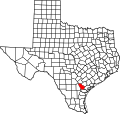2020 census
As of the 2020 census, 31,047 people, 8,896 households, and 5,693 families resided in the county. The median age was 37.8 years; 19.4% of residents were under the age of 18 and 13.5% were 65 years of age or older. For every 100 females there were 155.7 males, and for every 100 females age 18 and over there were 172.8 males age 18 and over. [14]
The racial makeup of the county was 49.4% White, 7.7% Black or African American, 0.7% American Indian and Alaska Native, 0.7% Asian, <0.1% Native Hawaiian and Pacific Islander, 23.1% from some other race, and 18.4% from two or more races. Hispanic or Latino residents of any race comprised 62.5% of the population. [15]
45.8% of residents lived in urban areas, while 54.2% lived in rural areas. [16]
There were 8,896 households in the county, of which 33.8% had children under the age of 18 living in them. Of all households, 44.5% were married-couple households, 19.3% were households with a male householder and no spouse or partner present, and 29.1% were households with a female householder and no spouse or partner present. About 25.5% of all households were made up of individuals and 11.4% had someone living alone who was 65 years of age or older. [14]
There were 10,562 housing units, of which 15.8% were vacant. Among occupied housing units, 64.4% were owner-occupied and 35.6% were renter-occupied. The homeowner vacancy rate was 3.0% and the rental vacancy rate was 14.5%. [14]
2000 census
As of the Census [18] of 2000, 32,359 people, 9,061 households, and 6,578 families lived in the county. The population density was 37 people per square mile (14 people/km2). The 10,939 housing units had an average density of 12 units per square mile (4.6/km2). The racial makeup of the county was 67.85% White, 9.90% African American, 0.42% Native American, 0.51% Asian, 0.03% Pacific Islander, 19.15% from other races, and 2.13% from two or more races. About 53.93% of the population were Hispanics or Latinos of any race.
Of the 9,061 households, 37.8% had children under 18 living with them, 52.9% were married couples living together, 14.8% had a female householder with no husband present, and 27.4% were not families. About 23.7% of all households were made up of individuals, and 9.9% had someone living alone who was 65 or older. The average household size was 2.74, and the average family size was 3.25.
In the county, the population was distributed as 23.4% under 18, 13.3% from 18 to 24, 35.4% from 25 to 44, 17.8% from 45 to 64, and 10.2% who were 65 or older. The median age was 32 years. For every 100 females, there were 148.40 males. For every 100 females 18 and over, there were 164.90 males.
The median income for a household in the county was $28,392, and for a family was $32,967. Males had a median income of $26,473 versus $20,666 for females. The per capita income for the county was $10,625. About 19.70% of families and 24.00% of the population were below the poverty line, including 33.80% of those under age 18 and 18.30% of those age 65 or over.




